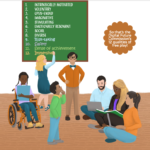
I don’t know about you, but I’m not always happy with how I spend my time with digital media. For example, when my stress levels are high, I spend lots more time reading news sites, checking out Instagram, or watching films. Because I follow a lot of nature photographers on Instagram, the photos have a calming effect. The news serves more as welcome distraction justified by keeping myself informed. My film viewing is complicated.
I prefer when I can be intentional about what news I read (or view)…and I’ve come a long way with that—my very conscious “news outs” changed my behavior around how, when, and where I take in the news. I find that I need frequent resets. Depending on what’s going on in the world, I can slide. Whenever possible, I try to go to primary sources—for example, this week, I watched the Democratic debates live and skipped the pundits’ filtered rehash. Instead, I talked with friends. I watched as much of Mueller’s live testimony as I could. I’ve been listening to the Commonwealth Club of California‘s wide range of podcasts. And I go to news sources online that lean towards longform and more in-depth interviews.
I work on my laptop for several hours a day (to be clear, I start my day off with early morning dog walks and I take lots of short breaks throughout the day). I have a large external screen and the laptop screen. I’m usually juggling multiple projects so, typically, I’ll have a dizzying array of browser tabs open while I work.
My problem with film is #TooMuchOfAGoodThing. When my brain is overheated (frequently), I can reach for an enormous hose blasting content 24/7 to cool off. Between iTunes movies, Netflix films, and Amazon Prime videos, a high volume flow of films are always just a click of relief away. This reminds me of my recent trip to a science museum with a one-and-a-half-year-old curious human. Coming out of the restroom with her, there was no way to avoid the wall of colorful stuffed animals for sale. We had to engage them. We picked up the awesome octopus and appreciated it. And of course, this young child was ready to take that awesome octopus home with us. Somehow I managed to explain that the octopus lived there and we successfully said goodbye. Whew.
I don’t think there is a “right way.” On another day, simply telling Awesome Octopus goodbye might not have worked.
But what I can do with films is notice. Notice when I open iTunes, even if it’s after the fact. Notice how I’m feeling. Notice what I’m drawn to…And I think I may need to experiment with a “film out.” My initial “news out” was for a week, but I extended it when I realized I seriously needed a reset and a week was not long enough. I’ll let you know how that “film out” goes.

How do you spend your time with digital media (on your phone, tablet, laptop, computer, or library computer)? And…how can you know what you’re modeling if you don’t have a very clear sense of how you’re engaging with digital media?
I’d like to suggest keeping a log for four or five days—noting as you go through your day what you’ve been doing. It might surprise you.If you think about different categories of content, what would your pie chart look like? Get specific in your log about the media you’re encountering.
Here are a few categories to consider.
Films/genres
Books/genres
Music
Video
News sites
Apps/genres
Games
I have one rule for this experiment: Non-judgmental.
If one person loves fashion and another reviews graphic novels for kids, your percentages are going to be really different. Appreciate your categories. Reflect on where you’re in default mode, and where you’re exploring new territory. Think about how/when/where you might like to extend or explore in new ways. Where could you use a reset?
Here’s an invitation: Curate some content worth sharing. Send it my way and I’ll share it with people in one of my next posts. It could be a photo you loved. It could be a podcast, a film review, an analysis of recent events in Brazil, or a website that reviews fiction for tweens and teens.
Practice curation.


